If you are having privacy issues in your backyard, there are many ways you can approach the problem. From my landscape design experience, plus some additional research, I’ve found 11 different methods you can use to block your neighbours from view.
We’ll consider different materials, layouts, combinations of these, and price points. Then I’ll provide a little summary table suggesting what kinds of spaces/ yards this method is suitable for, and a price range (such as low $100’s – high $1000’s).
Below is a list of the different methods/ approaches. You’ll see my descriptions are a little different than other sites.
Click the link to go directly to that section.
- Use Hedges Or Screening Plants To Partially Or Fully Block Neighbours
- Trellises/ Lattices To Block Neighbours – With Or Without Plants
- Raise The Garden Bed And Halve Your Potential Growing Time
- Layering Your Garden With Plants To Add Bulk To Block Neighbours
- Layering Your Garden With Trees To Spread Vertical Elements Across Your Yard
- Block A Specific View Into Your Yard – Or A Specific Part Of Your Yard
- Use Man-Made Components Like Walls, Screens Or Poles
- Use Blocking Screens For Temporary Privacy
- Look At Layering Your Garden/Screening Over Time
- Design Private Areas Out Of View Behind Buildings
- Lower Your Private Spaces Below Ground Level
Before we get started, I want to outline three important points to think about BEFORE you decide on the best method for your situation.
What, Where & When
When it comes to hiding or blocking neighbours, you need to think about what you want to block. Is it a specific thing in your backyard? Or block a view from their side (like their windows or other overlooking spaces)?
You also need to determine where you will do the blocking – along your property boundary, at your specific ‘exposed’ area, or in between.
Lastly, you want to put a little bit of thought into ‘when’ you want to block a view – always, or only for temporary things like entertaining?
This is what professional landscape architects and designers consider before looking for solutions. So you allocate resources effectively, and put more money towards the things that matter.
You can use one or a collection of the methods we’ll explore below. For some methods, the examples may require a bit of imagination to apply to your situation, but most should be simple enough to understand.
Let’s start by exploring the ‘what’, ‘where’ and ‘when’ to block elements I touched on above.
Consider What You Want To Block
This is straightforward. Are you trying to block your neighbours from viewing your whole yard or space? Or are you more concerned with a specific view looking into your site – an overlooking window, or outdoor space perhaps?
Perhaps there isn’t a specific view looking in, but you want to create more privacy around a specific area in your yard – like an entertaining area or relaxing space.

Defining the what can help you narrow your focus. So you don’t go over the top and plant a giant hedge, when all you need is a little screen.
Consider Where You Want To Place Your Blocking Components
So if you know what you’re trying to hide/ block from view, you can consider where you place your ‘blocking components’. Blocking components are the physical things that will do the blocking.
Obviously we have natural options – bushes, trees, screening plants, hedges, climbers and more.
We can also use manmade things like fences, screens, lattices/ trellises or poles – perhaps recycled versions of these as well.
And, of course, we can use combinations of these things.
Now when I say ‘where’ I mean where on your site/ property will you place these things? Realistically this can be seen as a ‘spectrum’ – starting at the specific area you want to make private, running through the yard all the way to the property boundary.

This all depends on your ‘what’ from above. If you want the whole yard to be more private, you’ll focus on your property boundary. But, if you have a specific area you want to hide from neighbours, it may save you money and time to focus on placing blocking components immediately around it.
Consider When You Want To Use The Space/s And How Private They Need To Be
This refers to if you only care about privacy for temporary things, or if you want to block neighbours from view all the time.
Again, just like considering where you place your blocking components, thinking about when you actually want privacy may save you time and money.
If 80% of the time you’re ok being ‘exposed’ in this space, then you don’t want to go over the top and spend $1000’s when you could spend $100’s.
It may be you want privacy while relaxing outside, or only while entertaining. While the space isn’t in use, you’re OK with it being ‘open’.
The fix here might be looking at mobile things like screens, curtains or mobile garden beds. We’ll look at these methods in more detail below, but you get the idea here.
Think about when you use the space/s and how private things need to be.
Lastly, Consider Your Neighbours
It sounds weird to say consider your neighbours when you’re trying to block them or hide from them, but it pays to think about what they’re seeing – once your plan is in place.
If you put up something solid – a wall, fence etc. – think about what that will look like from behind.
Will it be drab, ugly or untidy?
What could you try to do to ensure they aren’t looking out onto a blank wall from their kitchen window?
If you choose to plant something, will it become a straggly, messy wall they then have to deal with from their side?
Is there something you could do (or attempt to do) to make sure you can properly maintain it – to keep it clean and respectable?
Just a little consideration can go a long way, and prevent tensions from forming, or escalating, down the track. If someone were to try and block you from view, you’d like them to take your view into consideration, wouldn’t you?
Let’s have a look now at some of the methods you can explore. We’ll start with some standard approaches – using plants to block your neighbours from view.
1. Use Hedges Or Screening Plants To Partially Or Fully Block Neighbours
This works well if space is at a premium. There are bound to be plants suitable for your climate and conditions that grow quickly, densely and either partially or completely block neighbours from view.
For example, plenty of courtyards or small spaces work well with plants like Bambusa textilis ‘Gracilis’ which grows quickly and with dense foliage.
Once you determine the where, and have some site analysis information about that specific position, you can take it to an expert like a horticulturalist. They should be able to suggest a few options that fit the bill for you.
You’re also likely to find something that suits your aesthetic or style. Just keep in mind, if you opt for something deciduous, you’ll find your privacy quickly disappears in autumn and winter.
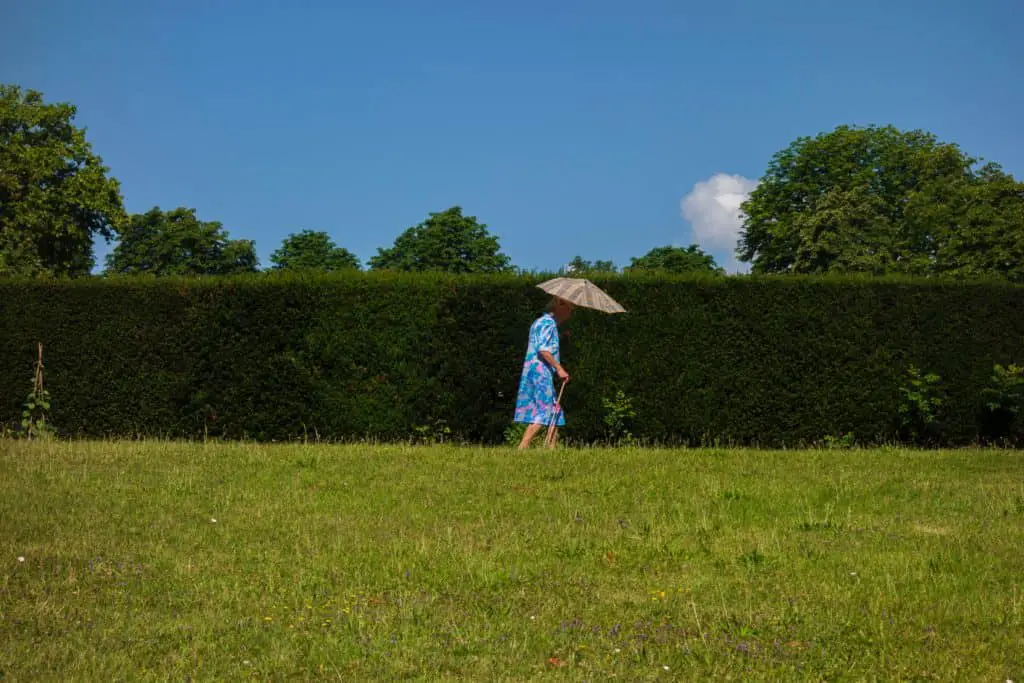
Photo by Philippe Leone on Unsplash.

Image from Piqsels.
Obviously these work well along property boundaries, but you can also place them around the specific area you want to seclude. Or even the ‘in between’ spaces throughout your yard – if you have space.
Be aware that things like hedges, and some screening plants, can grow quite tall and require a reasonable amount of maintenance. Yearly pruning to keep clean, bushy and control their height may be something beyond your interest, or ability.
And don’t forget to think about how you’d prune and maintain hedges or screening plants on your neighbours side (if it could impact them).
| Suitable For: | Price Range: |
| Balconies Courtyards Small Gardens 1/4 Acre Blocks Large Gardens * | Low $100’s – $1000’s Unlikely to get into $10000’s |
* Around specific areas, probably not property boundary
2. Trellises/ Lattices To Block Neighbours – With Or Without Plants
These are more heavy duty than using just plants. I use the terms trellis and lattice interchangeably, because what we’re talking about is a grid or crisscross of a material like timber, metal, wire or string.
They can help separate space – acting as their own ‘fence’. Or sit above existing things like fences, to increase the height of the barrier.
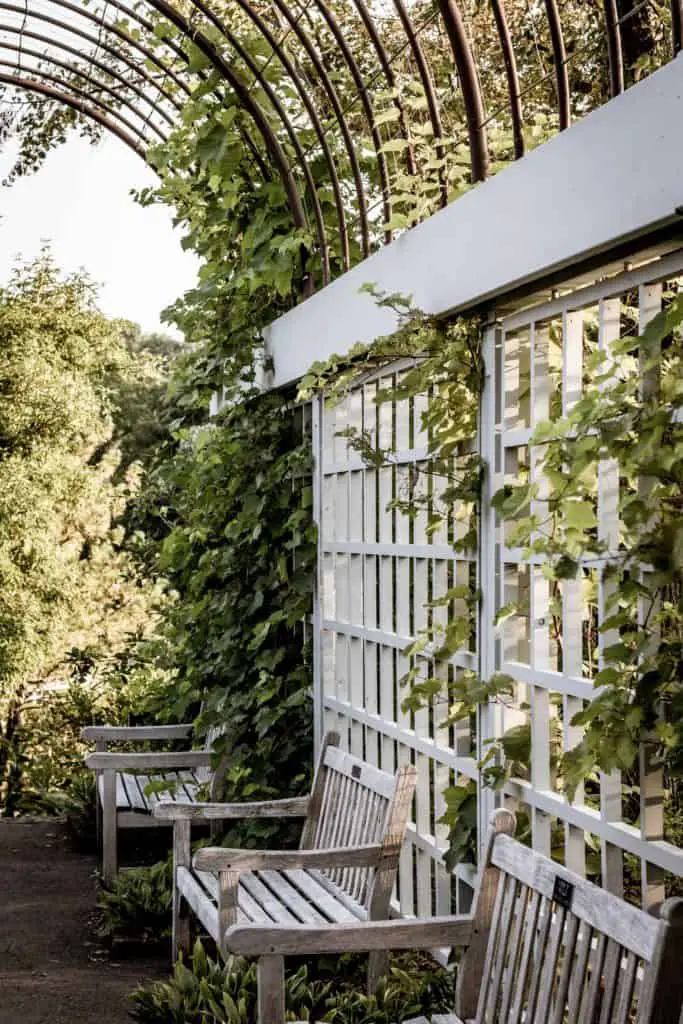
Photo by Bailey Gullo on Unsplash.
Trellises are often used as a support for climbing plants, which act to really block out neighbours. Given they tend to be somewhat permeable on their own, having something grow and cover them makes sense.
Another option could be espaliered trees – a bit more of a formal look, and may require some good maintenance and pruning, but can be a bit more structured than a climbing plant.
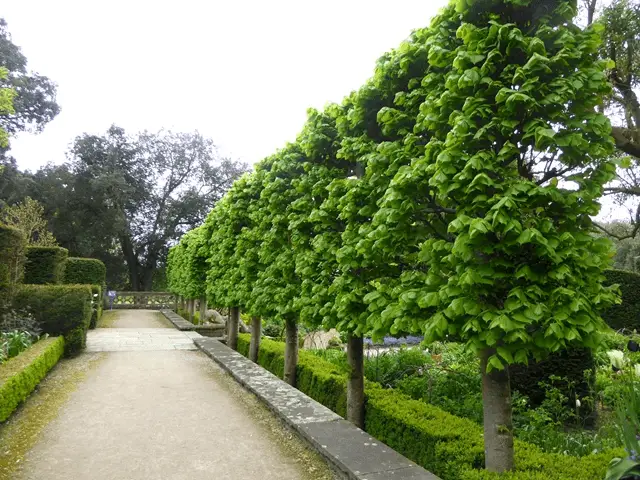
All that said, sometimes something semi-permeable may be just what you need, so a lattice/trellis set up without plants could be enough. Once again, consider how it would look and impact your neighbours.
| Suitable For: | Price Range: |
| Courtyards Small Gardens 1/4 Acre Blocks Large Gardens * Large Properties * | High $100’s – High $1000’s Depends on how much you need to cover, and if it requires footings |
* Around specific areas, probably not property boundary
3. Raise The Garden Bed And Halve Your Potential Growing Time
Rather than plant something at ground level and wait 5 years for it to block neighbours, you can raise the ground level and potentially halve that time.
You can look to plant things you normally would – things like hedges, screening plants, trees, grasses, and shrubs – and quickly get them to an ‘effective’ height.
Having them raised also makes them easier to care for. This is especially useful if you have mobility issues, or can’t move as well as you used to.
Raised Garden Beds
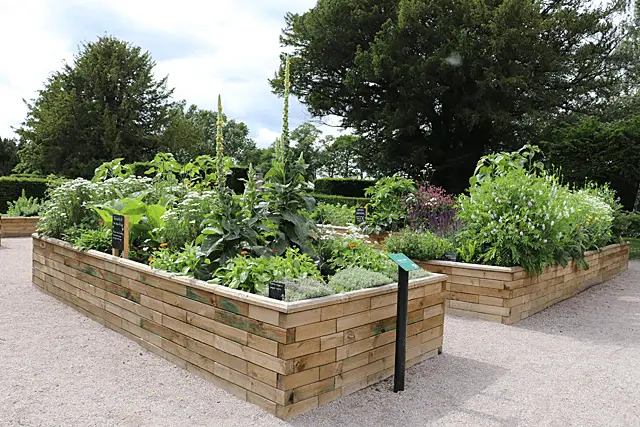
Photo by Anne Burgess.
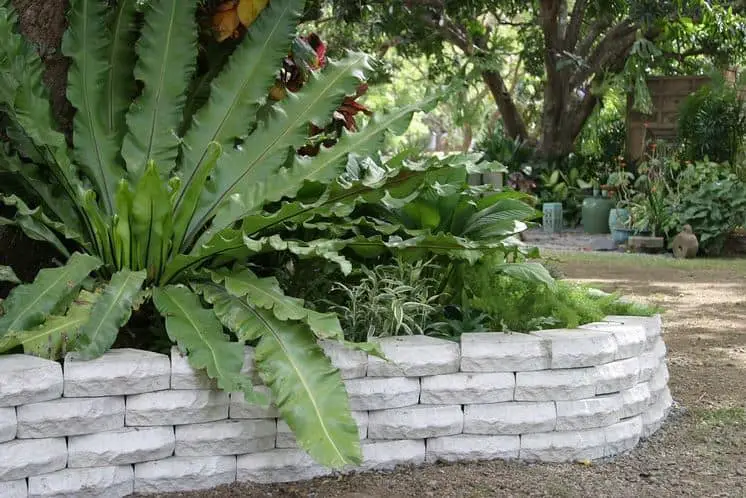
Image by Armcon Precast at flickr.
Raising your ground level could be as simple as a straight, built garden bed that you line, fill and plant with whatever you want. Screening plants would work quite well, or a collection of varying plants you could ‘layer’ – like above.
Pot/ Container Plants
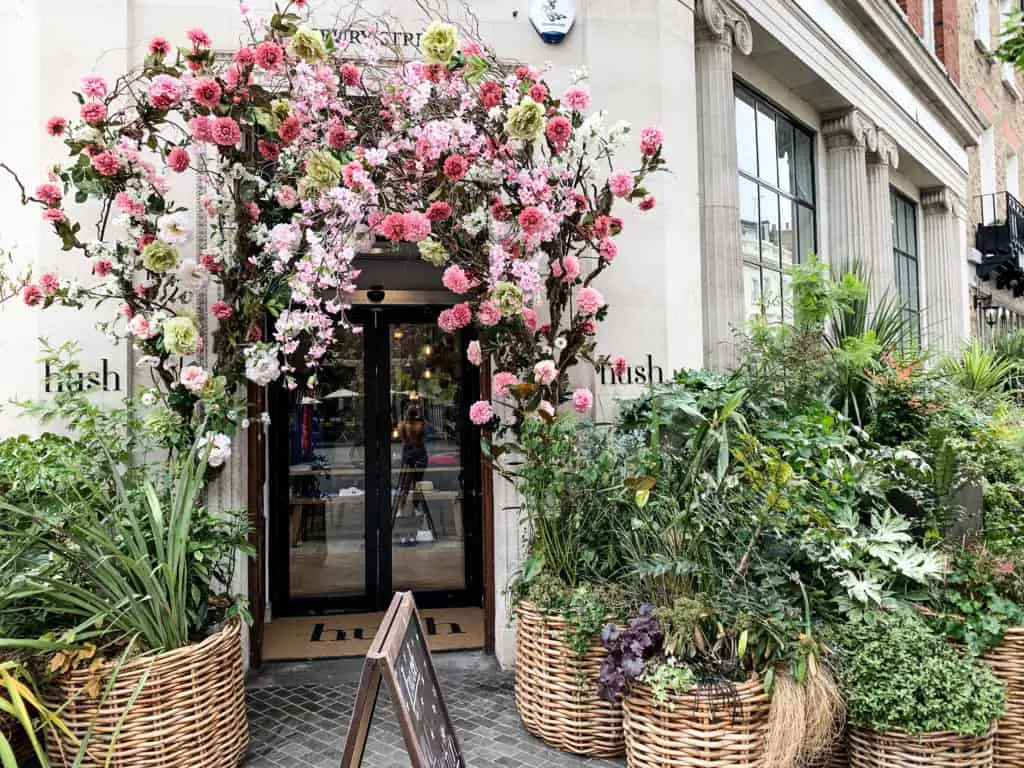
If building a full raised bed is too expensive or challenging, you can opt for pots or containers to achieve the same effect. These can also be mobile – something we’ll explore more later on – or stationary.
Just ensure you allow suitable drainage, and a place beneath the pots for water to drain or flow away. You don’t want your pots to slowly sink into damp or wet ground.
Landscape ‘Berms’
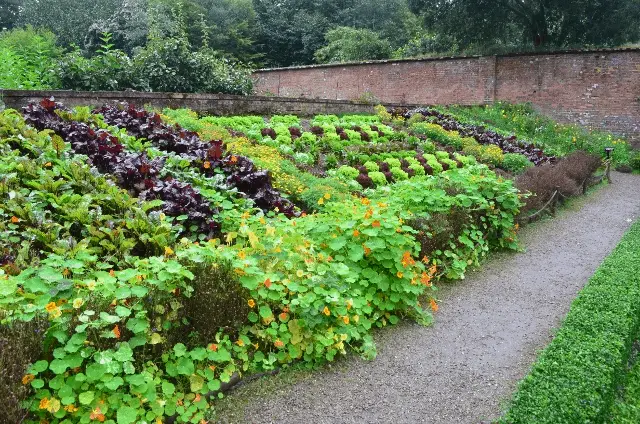
A third alternative is a ‘berm’ – a mound of earth that you plant things into.
This can be a cheaper version of a raised bed, but with a less defined shape. You then just plant whatever you want along the top and sides.
These probably work better on larger properties where you have space to spread out.
Benefits Of Raising Garden Beds
Another benefit of a raised garden bed, pots or containers, is you can line the inside with a waterproof membrane and/or weed mat.
This prevents leakages, and particularly invasive plants – like bamboo – from spreading to places you don’t want them to.
Not just other parts of your garden, but perhaps your neighbours too – especially if the bed is along your property boundary.
Not only can you restrict where plants grow, restricting the size of the root zone can also reduce the size of the plant. This can be useful to ensure trees don’t grow larger than you’d like. Or larger than you can manage.
If you do think a raised bed or container will suit your needs, be aware that building and installing these requires consideration and care to ensure you have adequate drainage and irrigation.
Do your research to ensure you find suitable materials and plant options for your location and requirements. Asking local builders, landscapers or horticulturalists is a good start.
| Raised Garden Beds/ Containers Suitable For: | Price Range: |
| Balconies Courtyards Small Gardens 1/4 Acre Blocks * Large Gardens * Large Properties * | Low $100’s – Low $1000’s Raised Beds can be expensive to build to unique sizes, but are available in set sizes of varying materials |
| Landscape Berms Suitable For: | Price Range: |
| Large Gardens Large Properties | High $100’s – High $1000’s If you need to order soil, along with machinery to move it, that will be an expensive, per day cost |
* Around specific areas, probably not property boundary
4. Layering Your Garden With Plants To Add Bulk To Block Neighbours
I’m going to expand this idea to be a little broader than you might expect. We considered the ‘where’ you place your plants in the beginning, so let’s explore this idea of layering across various distances.
At Your Property Boundary
Let’s start at the property boundary – probably the most common place people will look to place plantings like we explored in one and two.
When we talk about layering plants, we generally need a wider space than what’s required for a simple hedge or screening plants.
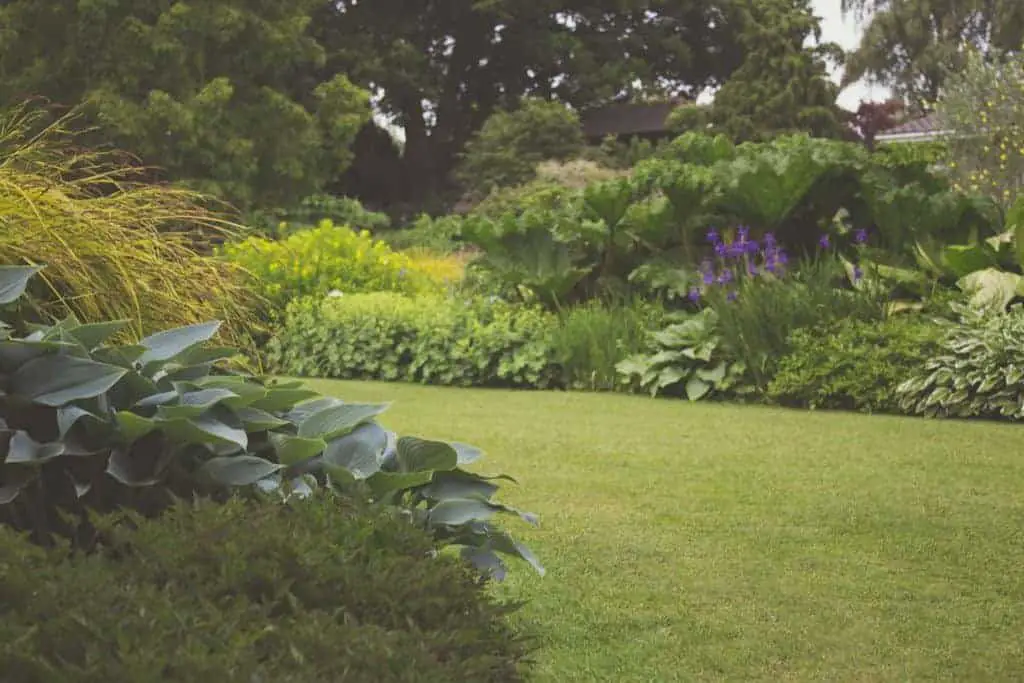
Photo by Creative Vix from Pexels.
The aim is to plant something that will reach a certain height – enough to provide privacy – and plant an undercarriage beneath it.
You can even finish off the bed with groundcovers extending out from the front row of plants – giving you multiple layers of different colours, shapes and maybe flowering periods.
Depending on your preferred style or aesthetic, you can opt for simple straight lines of the same plants, or a more natural, “mixed” bed of different things.
For the former, you are probably relying on each plant being healthy and well maintained. It can really ruin the look if you find a ‘dead spot’ – where some plants struggle to grow – breaking your continuous line.
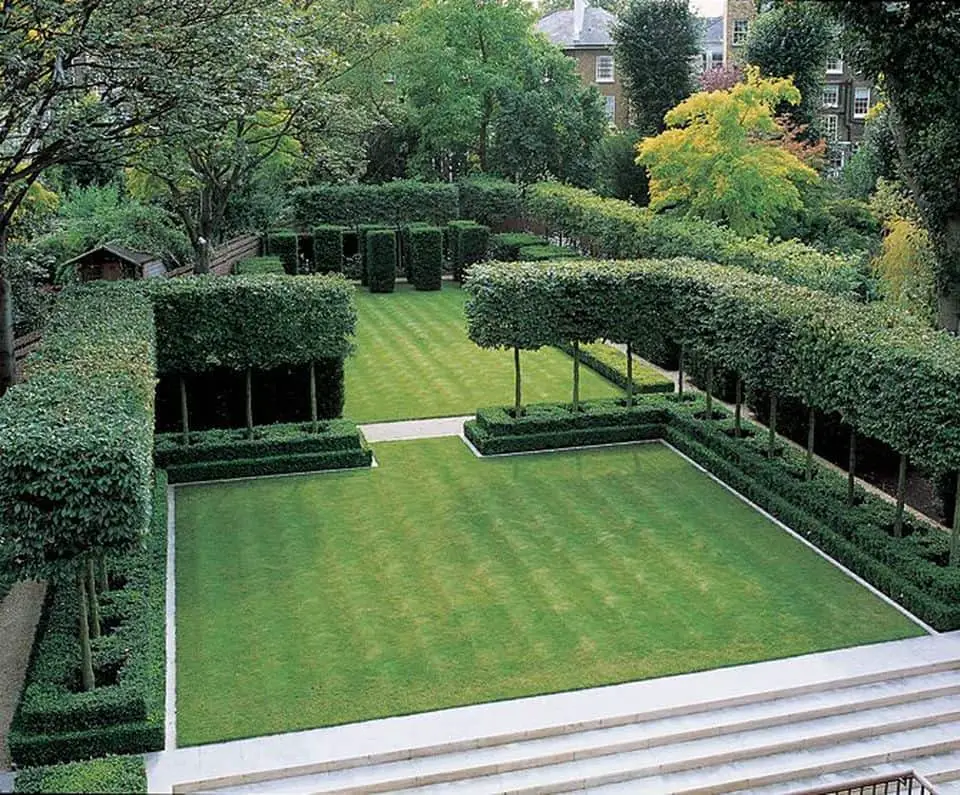
Image from Hoommy.com.
This suits a more modern or contemporary style, and if you choose suitable plants you can develop a nice layering of plants in quite a small space. Remember though – contemporary plantings may require more work to maintain in a ‘refined’ manner.
If instead you want to go for a larger, more natural look (like the image above), try to plant in a more mosaic pattern. Don’t have long continuous lines of plants.
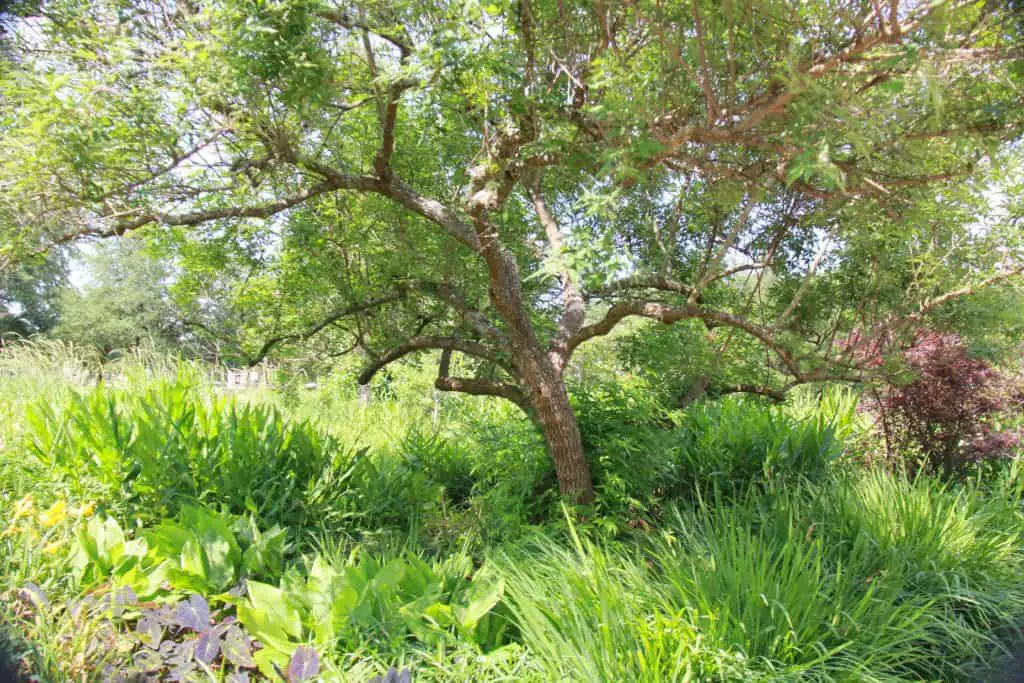
Image by May Guo at Pixels.
When you do plant multiples of the same plant together, plant in smaller groups and make sure they are odd numbers. Tessellate them – such as starting with two next to each other, then plant another in front and behind, between the first two. This ‘massing’ tends to look more natural.
Regardless of your style, having groundcovers, low and medium levels beneath your main ‘blocking’ plantings will add some lovely depth to your garden. Layering plants generally softens the space and also reduces noise.
Spread Layers Out Across Your Garden/ Landscape/ Yard
Instead of placing all your layers (what I’ll call the ‘ensemble’) at your property boundary, you could look to dot your respective layers throughout your landscape.
This is particularly effective if you have a specific point you may be viewing from – like your entertaining area, or a room in your house.
You would approach this a little differently than layering along your perimeter. The main thing to remember is that these now become 3D objects.
Now you care more about the side you can’t immediately see, because you will see it from another part of your yard.
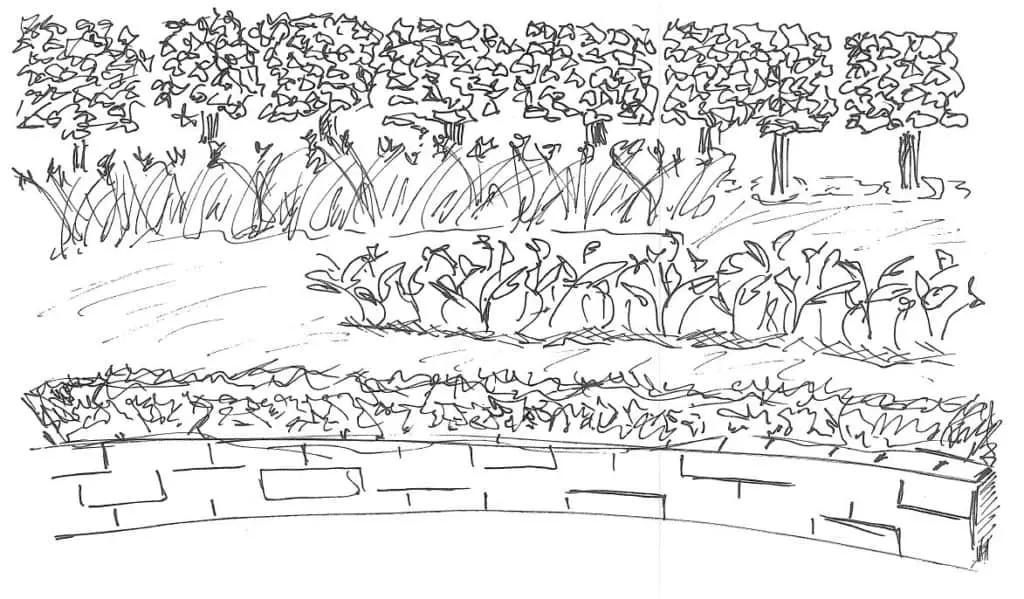
You can choose to break up the ensemble into separate layers, and place each layer at different locations. So you have your ground or lowest layer closer to you, and then dot the other layers at different points leading back towards your boundary.
Also, you don’t need to have long lines of each layer if you don’t want to. You could break up a layer into multiple lines and place those at different points if you want.
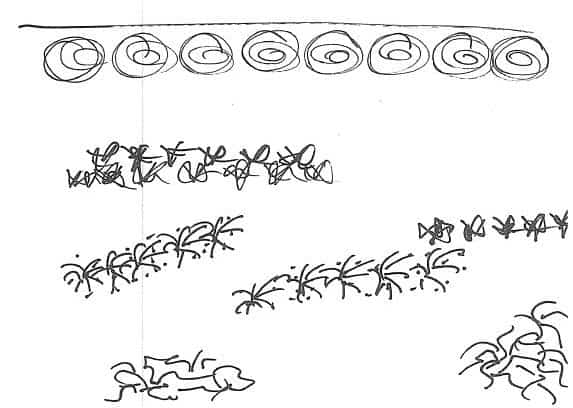
Another tweak is to keep the ensemble together, but break the whole thing apart into different clumps.

So have your ground, lower and middle layers – along with the canopy – together, but have multiple little ‘groves’ of them dotted throughout the yard.
It can achieve the same effect as breaking up your layers, but gives you more flexibility to place things in varying positions. And size each ‘grove’ differently if you need to.
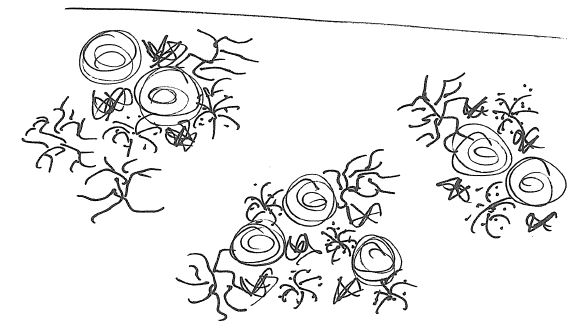
So you can see this concept of layering goes beyond just lines of plants along your fence. Let’s look at another way you can layer things, but with a slightly different focus.
| Suitable For: | Price Range: |
| 1/4 Acre Blocks Large Gardens Large Properties | High $100’s – $10000’s Depending on plant size/maturity, number of plant layers and where you want to place your plants |
5. Layering Your Garden With Trees To Spread Vertical Elements Across Your Yard
Similar to the example above, you can think about blocking neighbours from view using vertical elements like trees.
Although these are probably the easiest to place and work with, you could try to add other potentially tall things we’ve touched on like trellises, grasses or raised garden beds.
All of these will, with varying degrees of success, block or obscure a view.
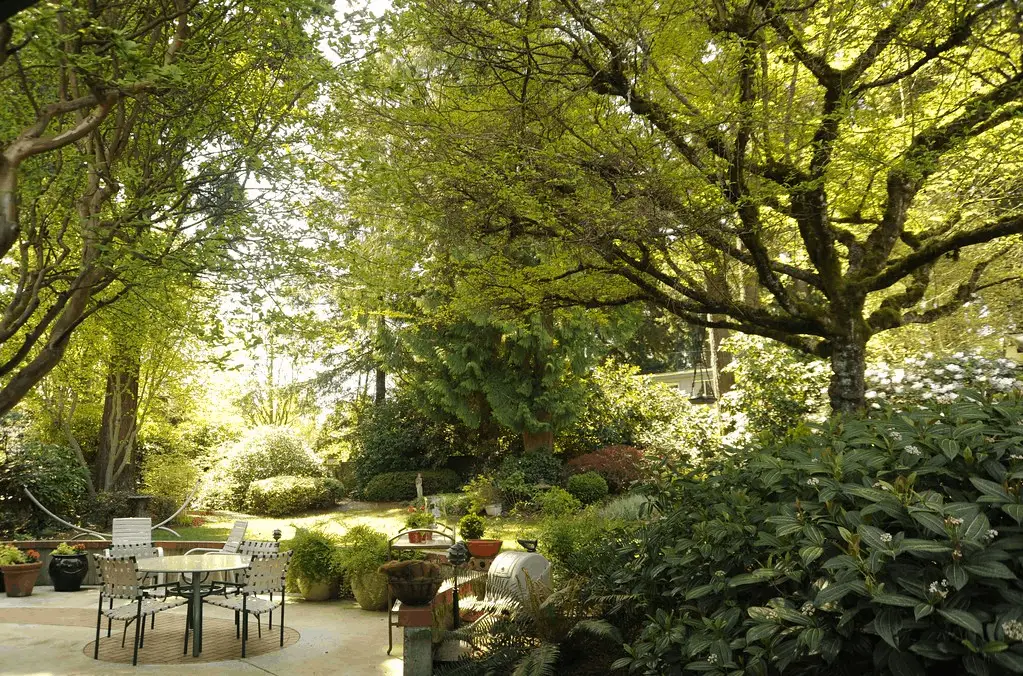
Image by Wonderlane at flickr.
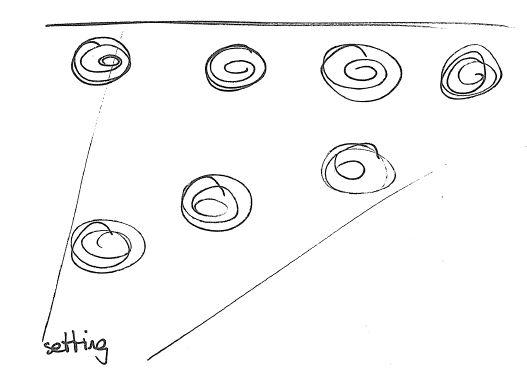
I think the main difference between this and point four is you don’t need to focus on the layering the undercarriage as much. You choose, and rely on, the vertical elements to do the blocking job.
This probably better suits smaller backyards or courtyards. Yards without much room horizontally, but can spread out a bit more vertically.
Additionally, having a few vertical elements popping up within the space will add a bit of depth to it.
This works well with thinner components – narrow trees like silver birch, or, as we’ll touch on later, things like upright poles.
| Suitable For: | Price Range: |
| Courtyards Small Gardens 1/4 Acre Blocks Large Gardens ^ Large Properties ^ | High $100’s – $1000’s Could go higher, depends on number of trees and size More likely to be cheaper than layering plants |
^ Trees can work on larger scales, but may rely on larger spreading, slower growing trees to fill out space effectively
6. Block A Specific View Into Your Yard – Or A Specific Part Of Your Yard
We’ve seen a few approaches to making a space more private. This point harks back to my original question at the start.
Do you need to block everything along your fence line, or are there just a few spots that bother you?
If you do have a few key spots that overlook or impose upon your privacy, you can deal with these far more cheaply by planting a few well placed trees.
Again, you can determine where exactly you place those trees.
Are they right next to the space you want to enclose? Or carefully dotted throughout your yard? Or right up near your property boundary?
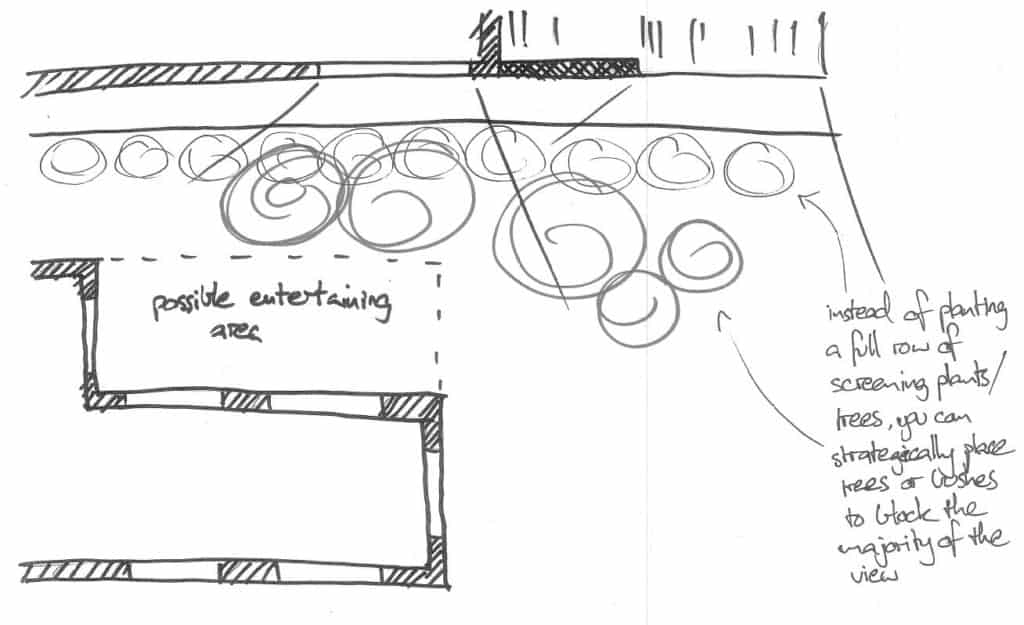
Targeting a specific area will most likely result in a cheaper, and potentially faster, outcome. You can put your money towards more mature trees, so they block your neighbours sooner.
And you can refine your choices even further by trying to determine how wide and tall you would need your tree/s or plant/s to be.
This may depend on where you position it to block views. Or perhaps you position it based on the growing habits and mature size.
One thing to note is living components like plants require pruning and other maintenance to ensure you get nice thick growth, rather than a straggly, leggy crown.
The denser you can make the tree, the better it will block your neighbours view.
| Suitable For: | Price Range: |
| Small Gardens 1/4 Acre Blocks Larger Gardens Large Properties | High $100’s – High $1000’s Depends again on number and maturity of trees Probably cheaper than Layering Plants or Trees (4. & 5. above) |
7. Use Man-Made Components Like Walls, Screens Or Poles
So far I’ve outlined a few ‘layouts’ focusing on plants. But there is no reason similar layouts wouldn’t work with man-made components.
We’ve touched on trellises/ lattices above, but I included those in the ‘planting’ section because often their main function is to support plant growth.
Again, think about ‘where’ you would like to place blocking elements like these.
Would they be along the fence line, dotted throughout the garden, or right up next to the entertaining/ relaxing space?
Same questions, same decisions, but using a different material palette.
A positive to all three options is that you can design them to cover exactly what you need covered. No waiting years, hoping nothing goes wrong, to finally block your neighbours from view.
Let’s look at a few of the other positives and negatives that come with using some of these components.
Walls / Fences
Walls / Fences are much more heavy duty than plantings, requiring footings and more involved construction.
And they sometimes require building permits. They are more constrained by regulations, which means they will be more expensive.
But, if they are a solid material like stone or brick, they are likely to last longer, and are better at reducing wind and sound.
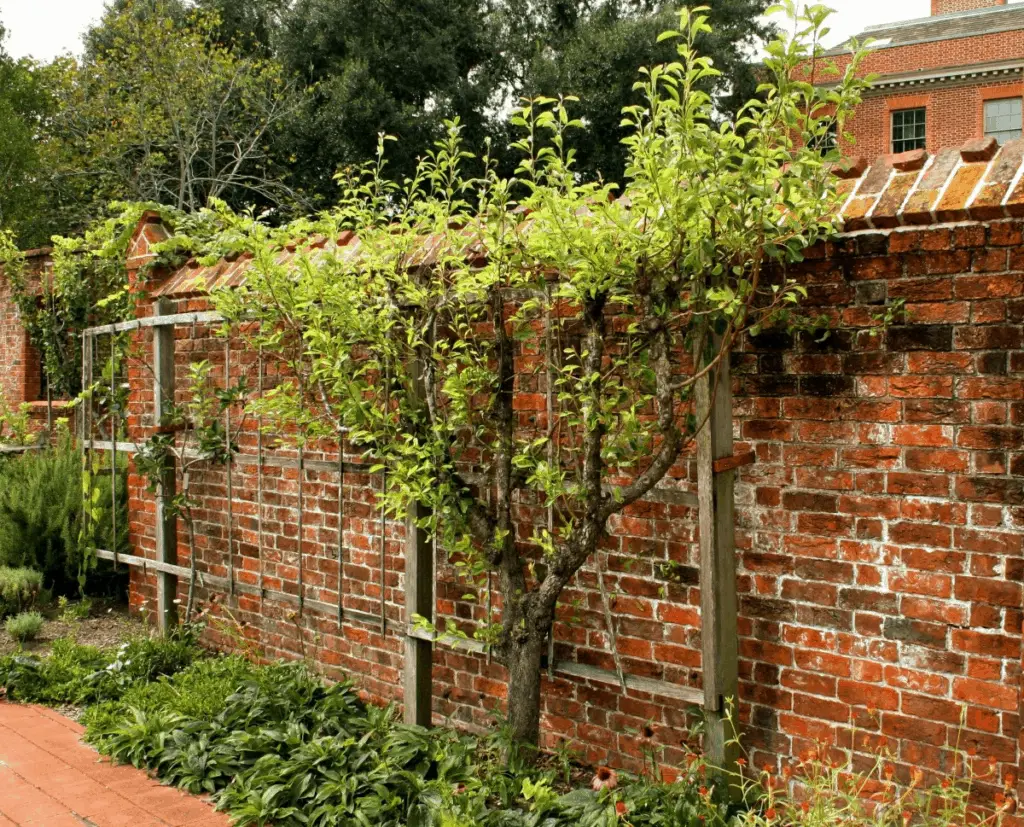
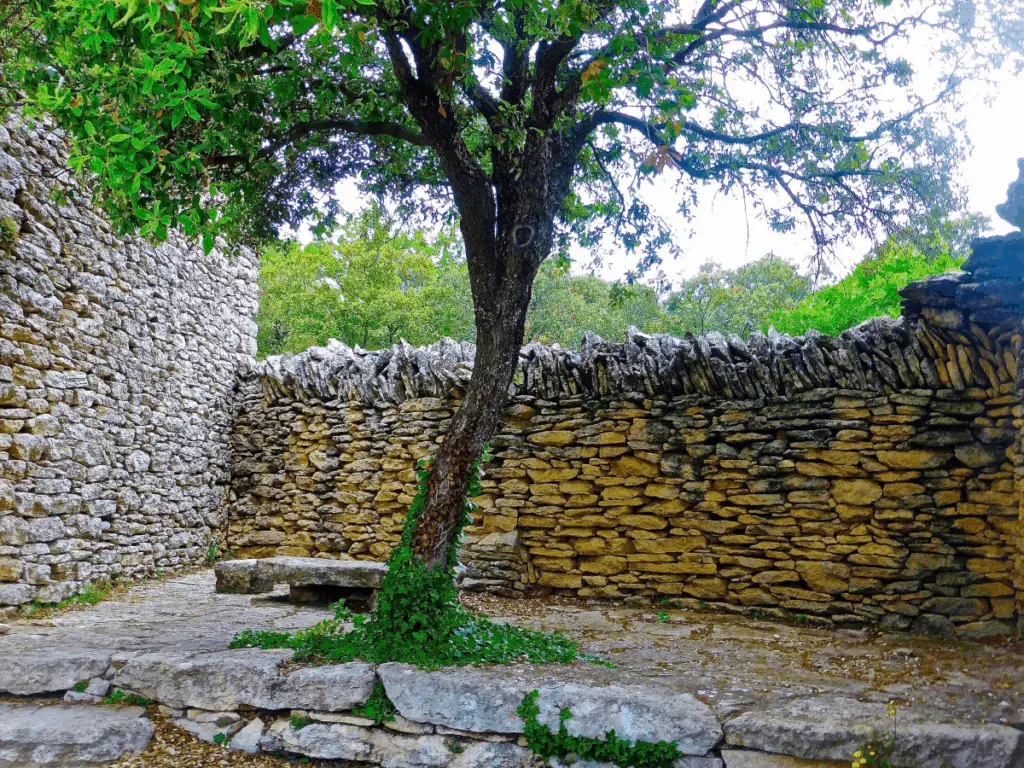
Screens
Screens are cheaper and can be very effective if you are more concerned with visually blocking something.
You can use a variety of materials – timber, metal, Perspex among others – and set up whatever privacy you need fairly cheaply. Some screens may need footings, which will add costs and labour, but are generally still cheaper than full constructed walls.
Just be careful you don’t place a screen where it may catch strong winds and become a hazard during storms.
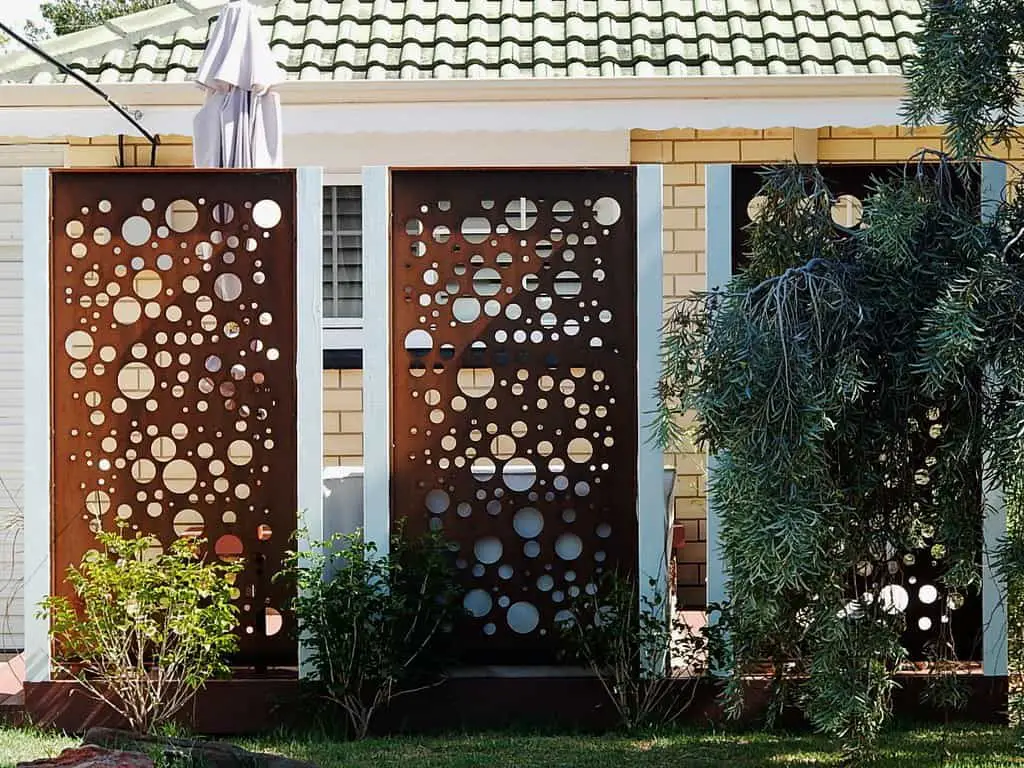
Bubble Screens – image by Michael Coghlan at flickr.
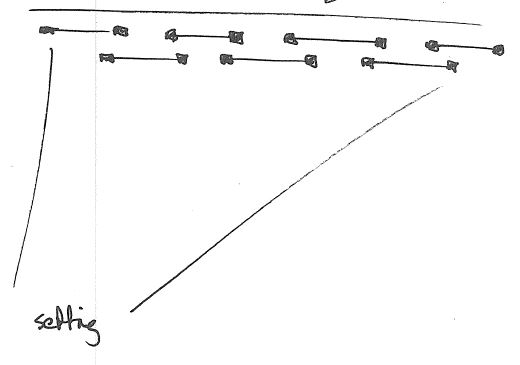
Upright Poles
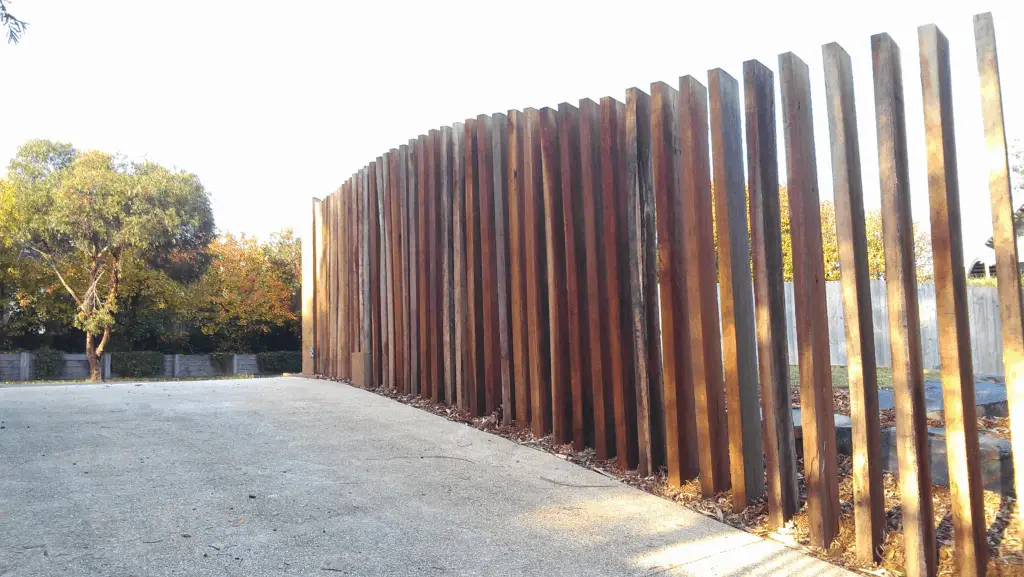
By Kuit Landscapes.
I mentioned upright poles previously. They could be a nice option to use strategically as upright elements, to break up direct lines of sight. Another option might be to use uprights in place of a full fence.
Spacing them provides a partial screen. Having two rows side by side – placed in each others gaps – can approximate a fence while allowing some light, breezes and sounds to pass through.
Screens and poles, in particular, provide a lot of layout flexibility. You can aim for the same layouts I outlined above, just using these materials.
Have layers, rather than a solid flat wall. Dot them throughout your landscape rather than against the boundary. Wrap them around, or nearby, the area you want to enclose.
Once again, the designing doesn’t change, just the materials.
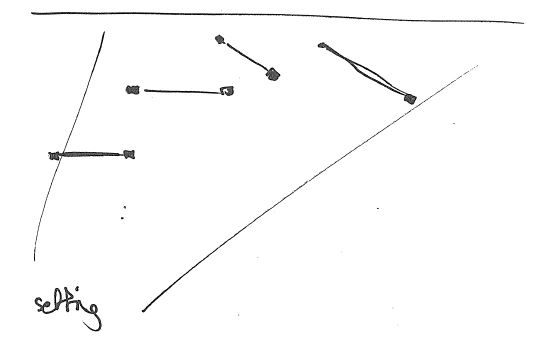
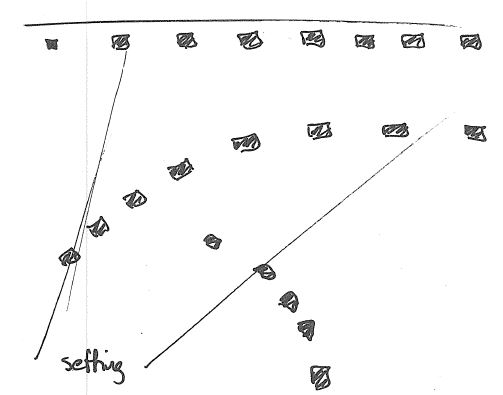
| Walls/ Fences Suitable For: | Price Range: |
| Small Gardens 1/4 Acre Blocks Large Gardens * Large Properties * | Low $1000’s – Low $10000’s Permits, builders, footings etc. add up to expensive options Timber clad fence is probably cheapest |
| Screens & Upright Poles Suitable For: | Price Range: |
| Balconies Courtyards Small Gardens 1/4 Acre Blocks Large Gardens *° Large Properties *° | Low $100’s – Low $1000’s Cheaper than walls/ fences even with footings Screens can cover more space per $ than a fence/wall can |
* Around specific areas, probably not property boundary
° Could be anyway from private area to property boundary
8. Use Blocking Screens For Temporary Privacy
I mentioned this right at the top – do you need to maintain a private space, or block neighbours, all the time? Or is it more for specific events, like entertaining family and friends. Or perhaps reading/ relaxing in your backyard?
There are many ways to make a space temporarily private.
Curtains
One is to build a frame and hang curtains.
These can be pulled away for most of the time, and then pulled closed when you’d like more privacy.
If you don’t want a frame, maybe a single line strung up across a space will be strong enough to uphold a few curtains.

Portable Screens
If having a whole frame set up is too much, you can have some simple portable screens nearby that you pull out and set up when needed.
A foldable room divider or dressing screen may be enough. You can get creative finding different things that are quick to set up and pull down.
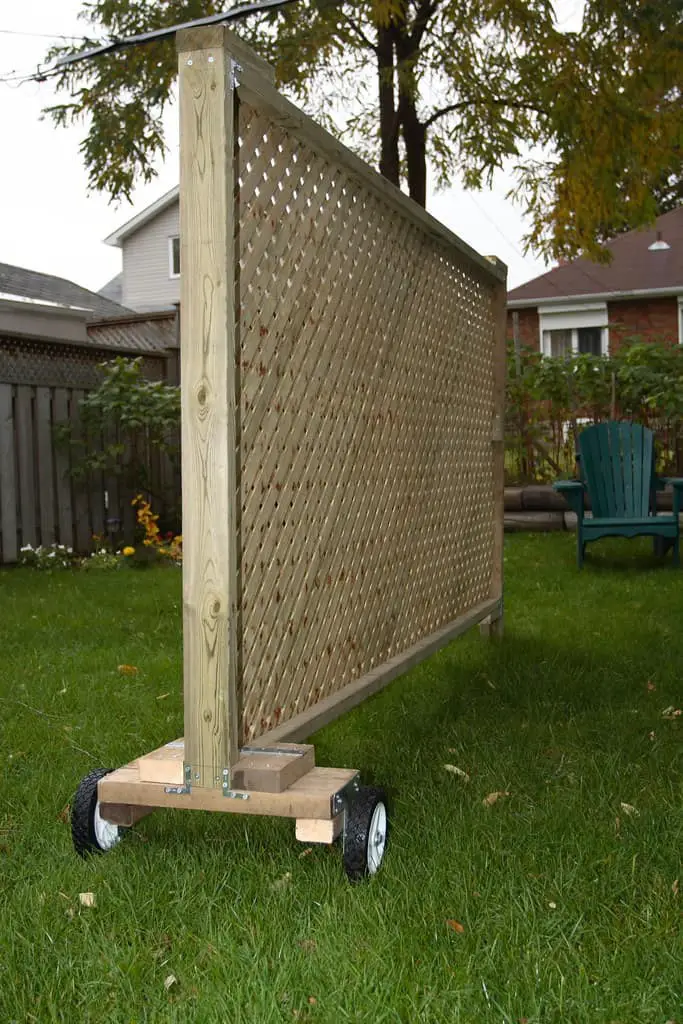
For something a little more robust, perhaps you have footings or sockets prebuilt, ready to go if you want to make your screen a bit more of a temporary wall.
When needed, you take up the uprights, slot them in place, and place your walls between. This is a little more technical and involved, but could be perfect for entertaining.
Mobile Garden Beds
Instead of screens or walls, what if you went for mobile garden beds?
I mentioned with containers, all you need is some wheels and smooth ground, and you can easily manoeuvre a few into place – provided they aren’t too heavy, of course.
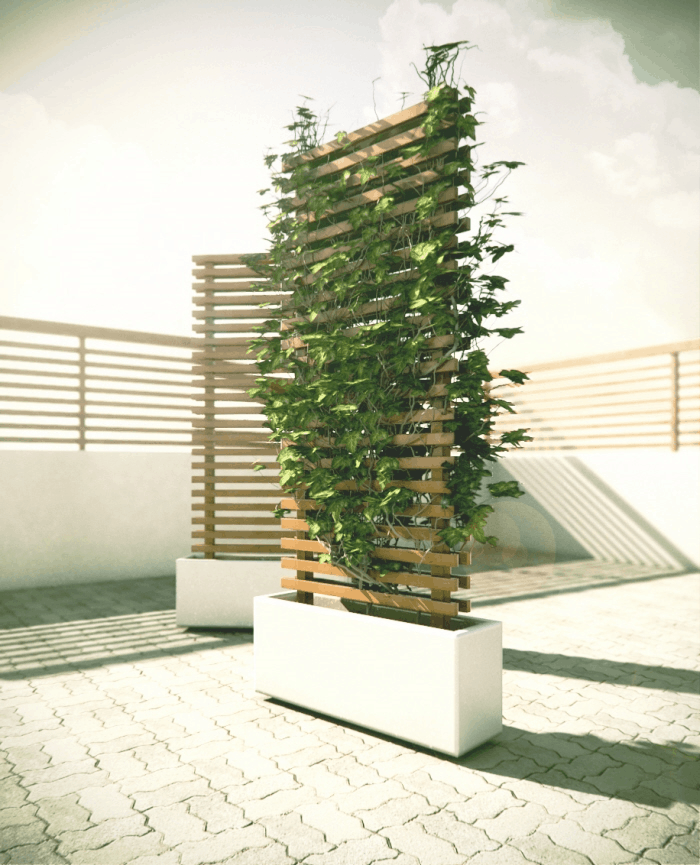
I think you can come up with a number of different, temporary options to provide some privacy when you want to use a specific space.
The one’s I’ve outlined here focus more on blocking neighbours at or around the area you want to seclude, rather than boundaries, so that is something to keep in mind.
A whole ring of curtains around your property may be a little difficult to manage…
| Suitable For: | Price Range: |
| Balconies Courtyards Small gardens 1/4 Acre Blocks Large Gardens * | Low $100’s – High $100’s Maybe more for mobile containers |
* Around specific areas, probably not property boundary
9. Look At Layering Your Garden/Screening Over Time
We’ve looked at a few ways to layer plantings throughout a backyard already. Let’s extend this idea, but doing it over time rather than across physical space.
This idea revolves around the varying life expectancies of different plants.
You may have a particular plant you would love as a boundary screening plant.
Or a particular tree or trees that will block a particular view.
The problem is they take years to grow to any kind of effective height or size.
One way to incorporate them into your design is to plant them in the necessary positions, but have other components next to them to do the blocking work until they reach a mature size.
After a few years, you remove the blocking option, leaving your preferred ‘slow growers’ to provide privacy. Think of this approach as a ‘succession plan’.
Blocking / Protecting Options
One option is to use things like screens. If you plant along a boundary, place your screens next to the boundary, with your slow growing plants a touch inside it.

Or, if you want something natural, you could use a faster growing screening plant, trees or hedge. If you go with plants, you want something that will live fast and die young.
Some flowering native plants such as Wattles in Australia have life expectancies of a decade or so, making them useful ‘protector’ plants.
So they won’t just block neighbours while you wait – they can also protect the slower plants from strong winds or storms.
Now this approach requires the removal of either option. Or in the screening plants case, you could let it grow old and eventually decay, but that may be messy.
Because you aim to remove the first wave of screens/plants you need to ensure you can still access them.
If your slow growing plants are reaching maturity, this may be a tricky job, so do some research and leave enough space.
This helps not only for removal, but for any maintenance you may need to do throughout the years – especially if your screening options are cheap and susceptible to damage that requires repair.
Planning Ahead
Once your first layer of plants or screens have been removed, you can replace them with layers of plants beneath the now mature ones.
Again, if you consider this from the start, you may be able to plant the look you want years in advance.
I know this option sounds like it will take decades (and it probably would), but you may find suitable choices for shorter timeframes.
Where the quick growing ones block neighbours within a few years, and your ‘slower’ options reach a suitable height ( or early maturity) within 6 or 8 years.
It’s certainly not for everyone, but it may something you’d like to consider. Especially if it allows you to expand your plant choices beyond quick growing hedge, trees or screening plants.
| Suitable For: | Price Range: |
| 1/4 Acre Block Large Garden ° Large Property ° | Low $1000’s – High $1000’s Depends on protection element and your slow growing choice Not to mention size of the area you want to plant and/or screen |
° Could be anyway from private area to property boundary
10. Design Private Areas Out Of View Behind Buildings
If you are designing your yard from scratch, and you have specific spaces you want to keep private (or views you want to block) you could consider hiding them in your overall landscape design.
Rather than use some of the components outlined above to block views, use existing parts of the landscape – or your house and other buildings.
This seems pretty straightforward – because it is! Not only does it make sense – it may end up being your cheapest option.
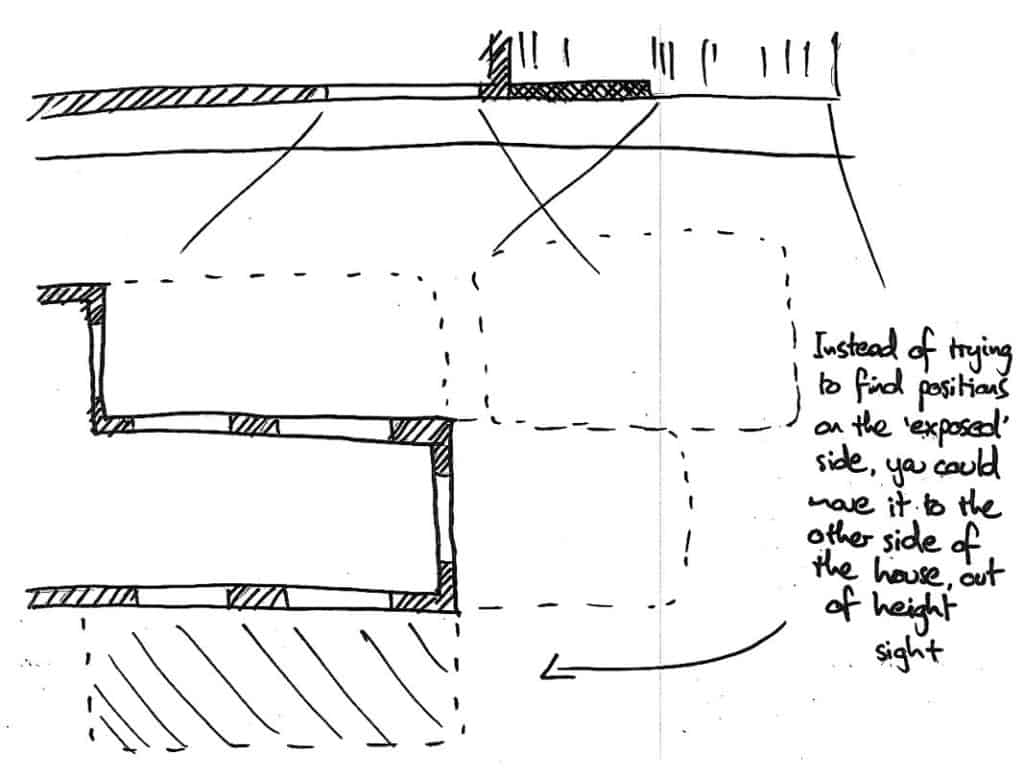
One thing to be wary of is compromising the usefulness, or enjoyment, of this space by placing it out of sight.
Don’t place your main entertaining, or relaxing, spaces in areas that are cold, windy, dark or other undesirable conditions (obviously this depends on where you live – in the tropics, those might be what you’re seeking).
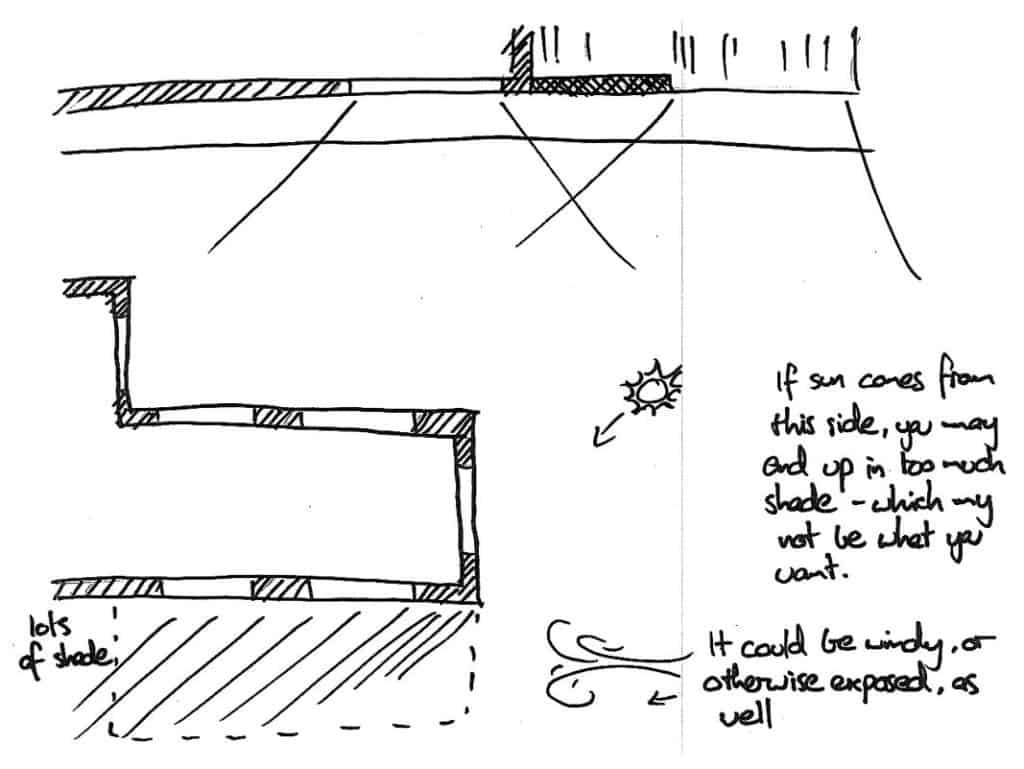
You want to enjoy these activities in positions that offer the best conditions. Don’t try so hard to find private spaces, only to place yourself in the worst parts of your yard.
If the most suitable conditions are elsewhere in the yard, and those positions are in view of others, then you’re better off looking at the other methods we’ve touched on above.
| Suitable For: | Price Range: |
| 1/4 Acre Block (possibly) Large Garden Large Property | Could be $0 especially if you can plan your landscape design before you build it |
11. Lower Your Private Spaces Below Ground Level
If you don’t have an opportunity to hide private spaces behind buildings, another option could be to lower a part of your backyard and literally build in a more private space.
This could require some potentially expensive landscaping work, but it may be something your site requires anyway – such as if you’re on a slope.
The basic idea is to cut down into the ground and shape it so you can use it to do whatever you want to do.

It could involve benches for seating or relaxing, or perhaps tables – maybe even a cooking or barbecuing area.
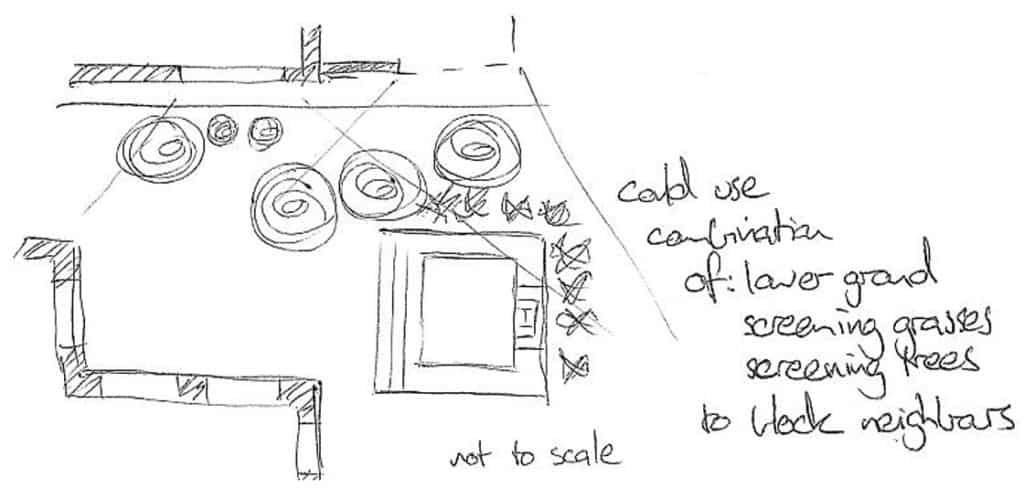
You’d want to ensure things are adequately lined, sealed, drained etc. – a fairly professional job, especially if it’s below other parts of your site.
The last thing you want is flooding and no way to drain excess water.

The appeal with this approach is you can try to have a lovely freeform style to suit whatever you want.
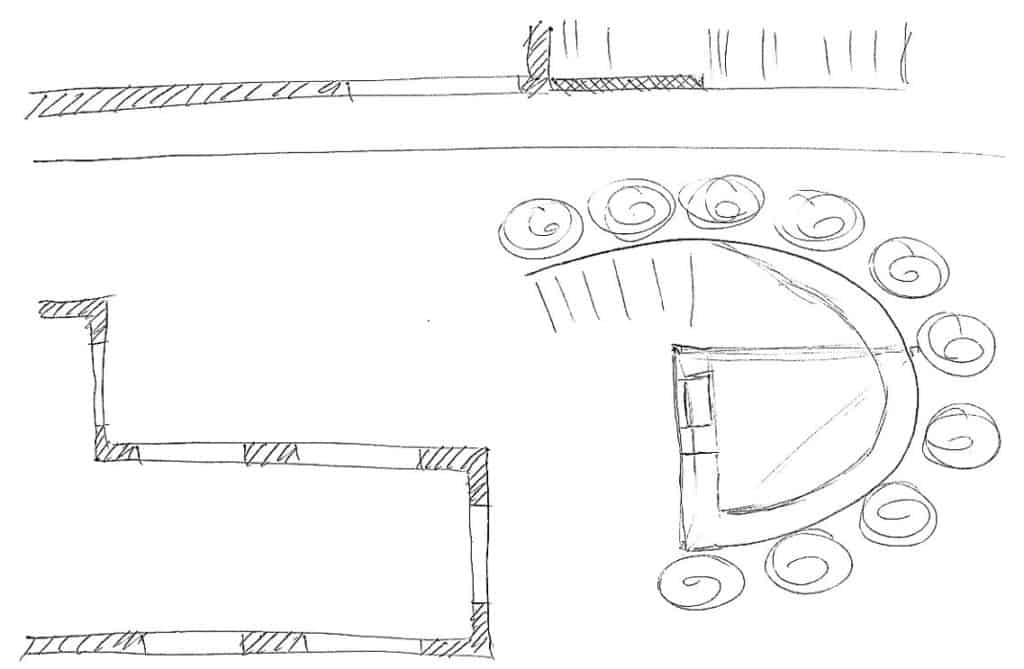
And you could put some fairly innocuous plants or other blocking components around the perimeter.
From the outside its a garden bed, hedge or series of screens. But from the inside it’s an entire entertaining space, hidden from view.
| Suitable For: | Price Range: |
| 1/4 Acre Block Large Garden Large Property | Low $1000’s – Low $10000’s Requires expert input to ensure design would be effective and construction would be adequate |
Conclusion
So hopefully you’ve discovered a few useful ways to block your neighbours from site.
Or at the very least determined what you want to block, where you plant to block it (in your yard) and when you want to block them.
One last point to help deal with this problem.
I suggest never attempting to solve an outdoor, or garden related issue, in isolation. Whenever you are trying to implement a solution, try to incorporate into part of an overall design.
This is because it’s very easy to think you’ve solved one problem, only to realise you’ve inadvertently created another by accident.
The best way to try and block your neighbours is to understand the methods outlined above, but look for opportunities to tweak an existing concept or design to accommodate those points.
This could be something like already having garden beds as part of a design. From looking at the info above, you tweak their position slightly so you also block your neighbours.
This way, you kill two birds with one stone. You have your original garden bed, but now rather than floating in space, it actually fulfils a purpose for you – providing additional privacy.
These are the kind of things you can layer into your design, should you try and develop an overall, site wide landscape design. If you’d like to learn how, check out any of my guides – the 6 Step Beginner Guide, or my ebooks in the sidebar – the Landscape Design 101 guide or my full, complete version – The Garden Design Process.
Finally, if you’d like to learn more about how to use similar ideas to the methods above, sign up for my email list and get access to my free Idea Generator Cheat Sheets.
They’ll help you unpack any image or piece of inspiration you find, and see how you can apply it to your garden.
If you want to offer your thoughts, perhaps correct something I’ve written or share your ideas, feel free to leave a comment below!

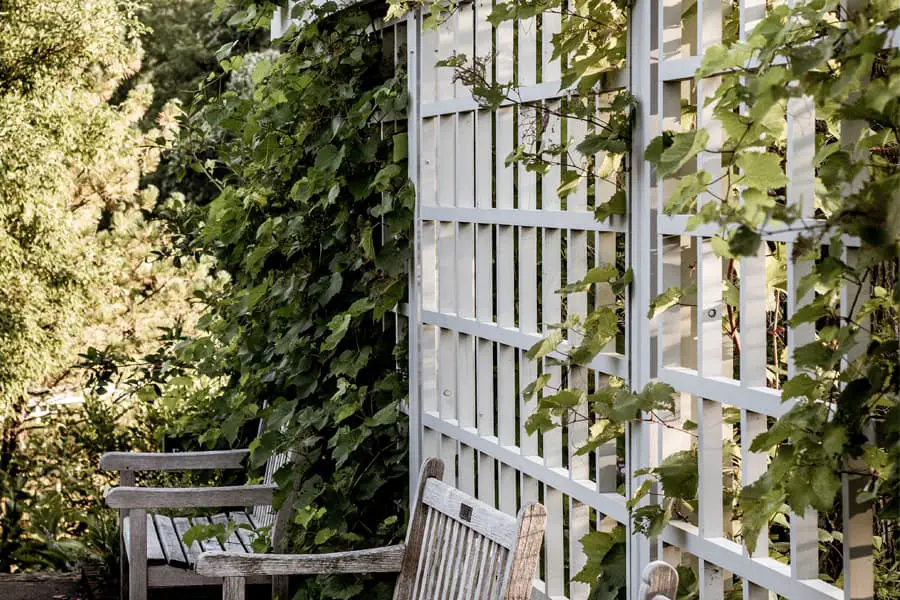
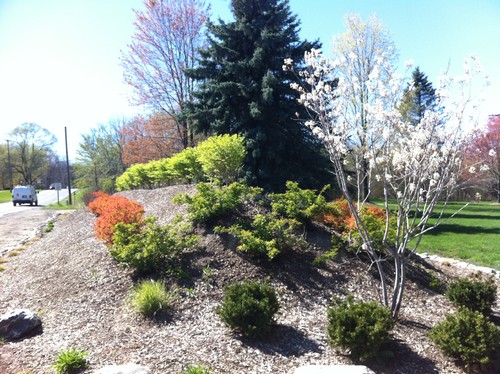
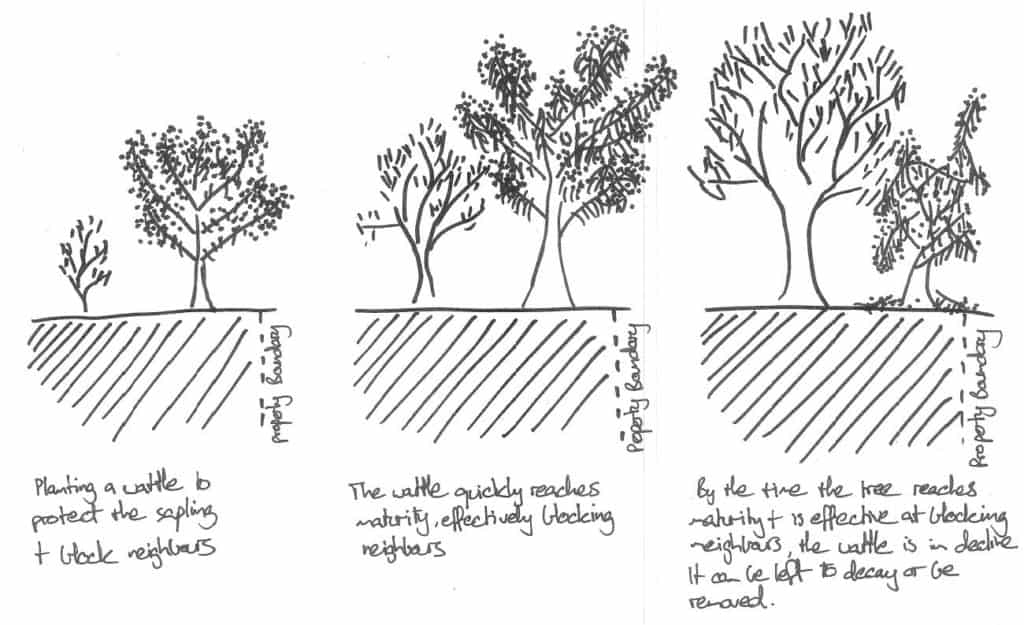
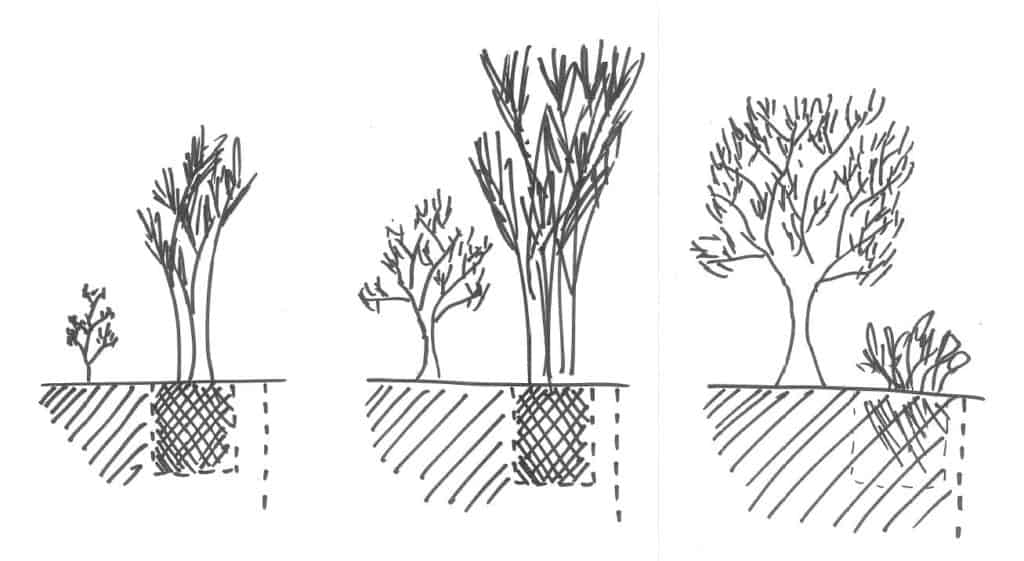
Thick brush vine fences being something that you can use to provide privacy to your landscape was an idea I really liked reading about from this article. While I respect my neighbors, I still want to make sure we aren’t bothered by them or any other suspicious people looking into our property in a very humble way. I’ll do this by hiring a landscape expert that can help me set up some vine and shrub fences for sure.
https://pgamarin.com/landscape-installation
Thanks for the tip about how using screens can be a good way to improve one’s landscaping seamlessly. I’d like to know more about how to effectively alter the view outside through landscaping because I’d like to add a bit more privacy to my property. That will help me be able to do more outdoor yoga and meditation without being too self-conscious about it.
https://hutslandscaping.com/landscape-design